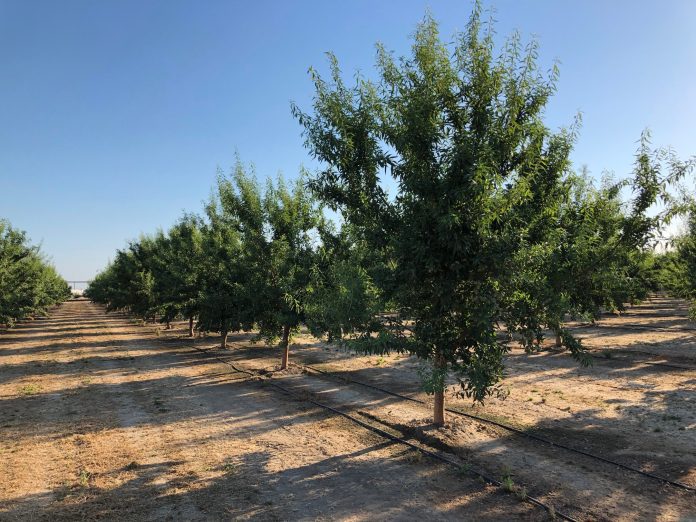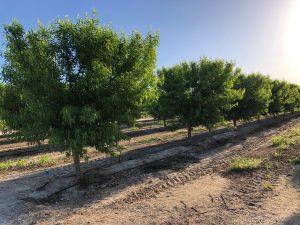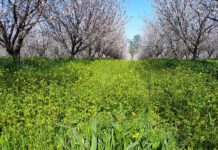
Agricultural resiliency is the land’s ability to maintain productivity and provide ecosystem services regardless of changing and often harsh environmental conditions. Resiliency largely depends on soil quality. Healthy soils capture and store more water, resist erosion during heavy rainfall and maintain higher levels of plant-available nutrients compared with degraded land(7). California’s orchards are uniquely positioned to improve resiliency by implementing regenerative practices aimed at developing healthy soils. While row cropping fields have limited capacity to accumulate organic matter due to frequent tillage, orchard soils can remain undisturbed for decades, allowing time for complex ecosystems to develop around the trees. Growers can improve orchard resiliency by adopting management practices that support the soil microbiome and facilitate healthy soil development.
Soil Health Starts with Microbial Activity
Learning about microbiology can help guide management plans aimed at improving soil quality. Microorganisms, including bacteria, fungi, archaea and protozoa, conduct a wide range of functions, and over time, their combined efforts significantly improve the soil’s physical and chemical characteristics. These organisms interact with each other and with arthropods, invertebrates and plants in complex food webs that capture energy and cycle essential nutrients to support each successive generation. Microbes include decomposers that break down plant litter and other detritus, grazers that feed on fresh carbon substrate, and predators that stalk, trap and kill their prey. Only a small percentage of microorganisms are pathogenic to plants, while most exert positive or neutral effects(6,7,8).
Direct and Indirect Effects of the Microbiome on Crop Production
Soil microorganisms support crop growth through direct interactions in the rhizosphere, the thin layer of soil directly adjacent to plant roots. Plant growth promoting rhizo-organisms (PGPRs), living on root surfaces or inside root tissue, form symbiotic relationships with plants. PGPRs include many types of bacteria, fungi and archaea that live in consortia, interacting with each other and with host plants. PGPRs feed on carbon-rich photosynthate exuded by plant roots, and in return, they deliver nutrients, enhance growth, suppress pathogens and trigger the plant’s immune response to biotic and abiotic stress(1).
Microorganisms living further away from plant roots contribute to soil and crop quality indirectly by improving the soil’s physical and chemical characteristics. Organic matter facilitates soil aggregation, lowers bulk density and decreases compaction. Microbes exude glue-like exudates that help flocculate soil into stable aggregates separated by pore space. Soil flocculation improves root health by increasing aeration and space for root elongation. Good connectivity between soil pores allows water and nutrients to move freely and evenly throughout the soil, improving fertigation uniformity and application efficiency. Organic matter not only improves aggregation, but also acts as a sponge, greatly increasing the soil’s water holding capacity. Soils with high organic matter content retain surplus water for later use, decreasing loss to groundwater due to leaching. Stable aggregates resist erosion and enable fast water penetration, allowing fields to absorb more water during heavy storms and long irrigation sets with minimal risk of runoff to surface waters(5,7).
Increasing organic matter and microbial activity also improves nutrient availability and retention in the root zone. Organic matter buffers pH and provides both cation and anion exchange capacity, allowing the soil to store more nutrients for future use(5,7). Soil microorganisms excrete complexing agents that bind essential elements in plant-available form(7). Living microbial biomass increases fertility even further by serving as a nutrient bank account, holding essential elements in living cells. Metabolic processes and microbial community turnover slowly release plant-available nutrients into soil solution, reducing the amount of fertilizer required to support the crop. Nitrate levels in healthy soils are often lower than in conventionally managed fields, but crops remain well fed by consistent N release from microbial biomass(4). Lower soil nitrate levels in soil solution reduce nitrate leaching, protecting groundwater quality while improving nutrient use efficiency.

Regenerative Practices Improve Soil Health
Research studies and grower experience demonstrate many benefits derived from building healthy soils, yet ag professionals continue to search for the most effective and economical methods to develop quality soil. Research conducted in California on sixteen almond orchards in 2018 and 2019 found dramatically higher soil quality when growers implemented four crucial regenerative strategies, including permanent groundcover, minimizing tillage, avoiding synthetic agrochemicals and applying organic amendments(6). This multi-pronged approach feeds microorganisms, protects their populations from damage and prevents organic matter depletion. Adopting just one practice like cover cropping provides a good start, but significant changes in soil health require several management changes implemented simultaneously over long periods of time.
The 2018-19 study found that regenerative orchards had higher soil organic carbon, higher water holding capacity, lower bulk density and higher microbial abundance than conventional fields. Pest and disease pressure were equal between conventional and regenerative farms, even though regeneratively managed crops did not use synthetic crop protection products. Quality and yield were equal between regenerative and conventional orchards, but lower expenses and premiums for organic almonds earned regenerative growers almost double the return on investment compared with their conventional counterparts. Regenerative management improved nearly every soil health metric while minimizing agrochemical applications required to sustain yield and crop quality(6).
Foundational Regenerative Practices
Providing constant ground cover pumps carbon into the soil, supporting greater microbial abundance and connectivity throughout the field(6). Ground cover also protects microbes from excessive heat and prevents harsh disturbance during heavy rainfall. Strategically chosen cover crops can provide additional benefits like pollinator habit and forage for livestock. Deep-rooted cover crops can help improve drainage and mine essential nutrients from deep in the soil profile bringing nutrition back to surface. Groundcover also protects surface water quality by decreasing erosion and runoff. Less water and sediment leaving the field prevents nutrients and pesticide residue from reaching surface waters(2,3,6,7).
Effective regenerative management requires maintaining microbial abundance and activity over long periods of time. Orchards managed without materials that disturb microbial populations observe more organic matter and improvements in soil quality than fields that frequently crash the soil ecosystem. Liquid organic fertilizers mineralize quickly into plant-available forms, while delivering additional carbon substrate to feed microorganisms(4). Highly concentrated fertilizers and many commonly used herbicides and pesticides stress kill microbial populations, disrupting nutrient cycling, pathogen suppression and soil carbon stabilization(6). Ongoing research may help elucidate microbial tolerance thresholds for fertilizers and pesticides, but for now, the best way to protect the microbiome is to use organic fertilizer amendments in moderate doses, avoid synthetic inputs, and even avoid copper containing organic fungicides(6).
Preventing soil disturbance gives microorganisms stable growing conditions and time to exert significant impact on the soil’s physical and chemical characteristics. Tillage disrupts the microbial habitat and introduces an influx of oxygen, which increases microbial respiration and growth rates well beyond levels supported in undisturbed soils. No longer limited by oxygen supply, microorganisms quickly feed on available carbon, burning through soil organic matter and releasing carbon dioxide. Avoiding tillage keeps oxygen levels stable, greatly increasing the probability of annual net carbon capture and organic matter accumulation(5,6,7). Net carbon storage becomes far more likely when growers also avoid harsh agrochemicals and provide a carbon food source with cover crops.
Regenerative management can help California’s farmers adapt to the changing climate, water shortages and ever-increasing pesticide and nitrogen use restrictions. The almond industry is poised for widespread change backed by positive research findings, grower success stories and food industry funding. Healthy soils lead to better root health, reduced reliance on ag chemistry and improved resiliency against both biotic and abiotic stress. Healthy soils also protect the surrounding environment by resisting erosion, preventing nitrate leaching and capturing more water during heavy rainfall to help recharge aquifers. Almond orchards span 1.6 million acres of California farmland, and if regenerative management practices are implemented on a large scale, the industry can help solve some of California’s most challenging environmental concerns.
References
(1) Beneduzi, A., Ambrosini, A., & Passaglia, L. M. P. (2012). Plant growth-promoting rhizobacteria (PGPR): Their potential as antagonists and biocontrol agents. Genetics and Molecular Biology, 35(4 suppl 1), 1044–1051. https://doi.org/10.1590/s1415-47572012000600020
(2) Bentley W, Hendricks L, Duncan R, Silvers C, Martin L, Gibbs M, Stevenson M. (2001) BIOS and conventional almond orchard management compared. Calif Agr 55(5):12-19. https://doi.org/10.3733/ca.v055n05p12.
(3) Bot, A. and Benites, J. (2005) Drought-resistant soils: Optimization of soil moisture for sustainable plant production. Food and Agriculture Organization of the United Nations, Land and Water Bulletin 11. https://www.fao.org/3/a0072e/a0072e00.htm#Contents
(4) Bowles TM, Hollander AD, Steenwerth K, Jackson LE (2015) Tightly-Coupled Plant-Soil Nitrogen Cycling: Comparison of Organic Farms across an Agricultural Landscape. PLoS ONE 10(6): e0131888. https://doi.org/10.1371/journal.pone.0131888
(5) Brady, Nyle C. and Weil, Ray R. (2008). The Nature and Properties of Soils. Fourteenth Edition. Pearson Prentice Hall.
(6) Fenster TLD, Oikawa PY and Lundgren JG (2021) Regenerative Almond Production Systems Improve Soil Health, Biodiversity, and Profit. Front. Sustain. Food Syst. 5:664359. doi: 10.3389/fsufs.2021.664359
(7) Magdoff, Fred and Weil, Ray R. Soil Organic Matter in Sustainable Agriculture. CRC Press 2004. Print.
(8) Mercado-Blanco J, Abrantes I, Barra Caracciolo A, Bevivino A, Ciancio A, Grenni P, Hrynkiewicz K, Kredics L and Proença DN (2018) Belowground Microbiota and the Health of Tree Crops. Front. Microbiol. 9:1006. doi: 10.3389/fmicb.2018.01006















